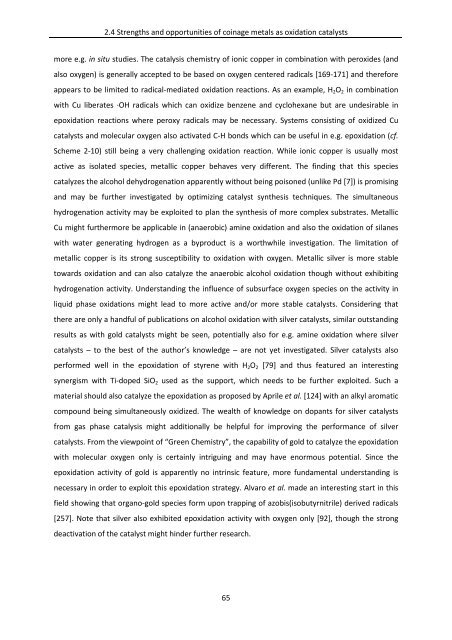Heterogeneously Catalyzed Oxidation Reactions Using ... - CHEC
Heterogeneously Catalyzed Oxidation Reactions Using ... - CHEC
Heterogeneously Catalyzed Oxidation Reactions Using ... - CHEC
Create successful ePaper yourself
Turn your PDF publications into a flip-book with our unique Google optimized e-Paper software.
2.4 Strengths and opportunities of coinage metals as oxidation catalysts<br />
more e.g. in situ studies. The catalysis chemistry of ionic copper in combination with peroxides (and<br />
also oxygen) is generally accepted to be based on oxygen centered radicals [169‐171] and therefore<br />
appears to be limited to radical‐mediated oxidation reactions. As an example, H2O2 in combination<br />
with Cu liberates ∙OH radicals which can oxidize benzene and cyclohexane but are undesirable in<br />
epoxidation reactions where peroxy radicals may be necessary. Systems consisting of oxidized Cu<br />
catalysts and molecular oxygen also activated C‐H bonds which can be useful in e.g. epoxidation (cf.<br />
Scheme 2‐10) still being a very challenging oxidation reaction. While ionic copper is usually most<br />
active as isolated species, metallic copper behaves very different. The finding that this species<br />
catalyzes the alcohol dehydrogenation apparently without being poisoned (unlike Pd [7]) is promising<br />
and may be further investigated by optimizing catalyst synthesis techniques. The simultaneous<br />
hydrogenation activity may be exploited to plan the synthesis of more complex substrates. Metallic<br />
Cu might furthermore be applicable in (anaerobic) amine oxidation and also the oxidation of silanes<br />
with water generating hydrogen as a byproduct is a worthwhile investigation. The limitation of<br />
metallic copper is its strong susceptibility to oxidation with oxygen. Metallic silver is more stable<br />
towards oxidation and can also catalyze the anaerobic alcohol oxidation though without exhibiting<br />
hydrogenation activity. Understanding the influence of subsurface oxygen species on the activity in<br />
liquid phase oxidations might lead to more active and/or more stable catalysts. Considering that<br />
there are only a handful of publications on alcohol oxidation with silver catalysts, similar outstanding<br />
results as with gold catalysts might be seen, potentially also for e.g. amine oxidation where silver<br />
catalysts – to the best of the author’s knowledge – are not yet investigated. Silver catalysts also<br />
performed well in the epoxidation of styrene with H2O2 [79] and thus featured an interesting<br />
synergism with Ti‐doped SiO2 used as the support, which needs to be further exploited. Such a<br />
material should also catalyze the epoxidation as proposed by Aprile et al. [124] with an alkyl aromatic<br />
compound being simultaneously oxidized. The wealth of knowledge on dopants for silver catalysts<br />
from gas phase catalysis might additionally be helpful for improving the performance of silver<br />
catalysts. From the viewpoint of “Green Chemistry”, the capability of gold to catalyze the epoxidation<br />
with molecular oxygen only is certainly intriguing and may have enormous potential. Since the<br />
epoxidation activity of gold is apparently no intrinsic feature, more fundamental understanding is<br />
necessary in order to exploit this epoxidation strategy. Alvaro et al. made an interesting start in this<br />
field showing that organo‐gold species form upon trapping of azobis(isobutyrnitrile) derived radicals<br />
[257]. Note that silver also exhibited epoxidation activity with oxygen only [92], though the strong<br />
deactivation of the catalyst might hinder further research.<br />
65



